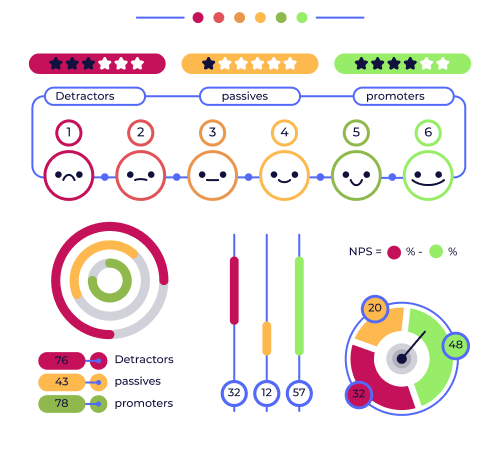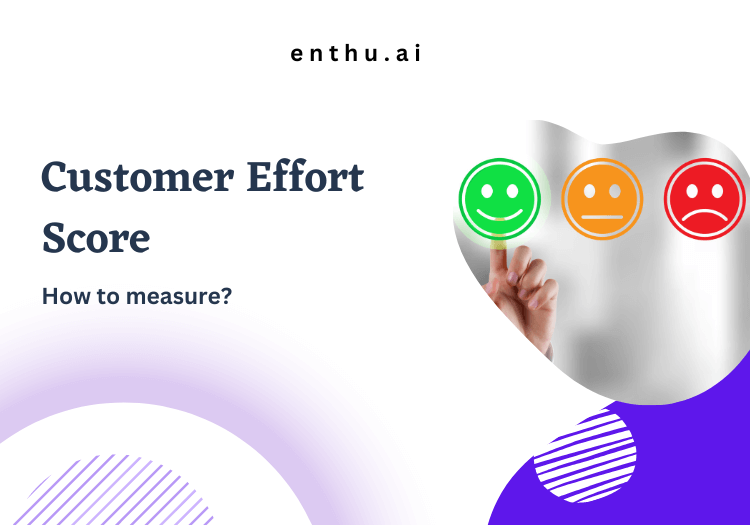It’s 4:50 p.m. on a Friday. You’re on the phone with customer support, trying to resolve a simple billing issue that’s been nagging you all week. You’ve already been transferred twice, had to repeat your account number three times, and are now on hold again. All you can think is, “This is way too much work.”
That feeling of frustration and wasted time is what the Customer Effort Score (CES) is designed to measure. It’s the antidote to those frustrating, high-effort experiences.
In this guide, we’ll cover everything you need to know about what it is and how to measure it so you can reduce friction for your customers, boost loyalty, and make your support operations more efficient.
Table of Contents
A. What is Customer Effort Score (CES)?
At its core, this is a single-question metric that measures the ease of a customer’s experience with your company. The easier you make it for customers to get their issues resolved, the more loyal they’ll be.
The “effort” in CES can be cognitive, physical, or emotional. Think about the mental gymnastics of navigating a confusing website, the physical clicks required to complete a transaction, or the emotional toll of dealing with a difficult customer service agent. All of these contribute to a high-effort experience.
CES is typically measured using a 7-point Likert scale. A customer is asked to rate the ease of their interaction, with responses ranging from “Very Difficult” to “Very Easy.”
B. How does CES compare to NPS and CSAT?
While many customer experience metrics exist, CES provides a unique and powerful perspective. Here’s a quick look at how it stacks up against some of the most common ones.
1. Customer Effort Score (CES)
- Purpose: To measure the ease of a specific interaction.
- Question: “How easy was it to handle your issue today?”
- Best for: Analyzing and improving transactional experiences like a support call, a service appointment, or a website purchase.
- Insight: A strong predictor of customer loyalty based on a single, recent experience.
2. Net Promoter Score® (NPS®)
- Purpose: To measure overall customer loyalty and sentiment toward your brand.
- Question: “How likely are you to recommend [Company] to a friend or colleague?”
- Best for: Understanding the big picture of your brand’s relationship with customers.
- Insight: Measures broad brand health and overall loyalty.
3. Customer Satisfaction Score (CSAT)
- Purpose: To measure satisfaction with a specific product, service, or interaction.
- Question: “How would you rate your satisfaction with the support you received today?”
- Best for: A quick, simple gauge of customer happiness with a specific touchpoint.
- Insight: Provides a snapshot of satisfaction, but doesn’t necessarily predict long-term loyalty.
C. Why CES matters for your business
Reducing customer effort isn’t just about making people happy – it’s about driving real business results.
1. A Direct link to loyalty
According to landmark research from Gartner (originally by CEB), reducing customer effort is the single most important factor for increasing customer loyalty. They found that customers with a low-effort experience were significantly more likely to continue doing business with the company. Customers with a high-effort experience are 4x more likely to be disloyal than those who had an easy time.
2. Impact on churn & retention
A high-effort experience is a leading cause of customer churn. Conversely, a smooth, low-effort interaction fosters retention.
3. Reduced operational costs
Less effort for the customer means less work for your contact center. By reducing friction, you can expect fewer repeat calls, shorter average handling times (AHT), and a decrease in escalations. These all directly impact your bottom line.
4. Improved employee morale
When your agents are able to resolve issues easily and efficiently, they feel a greater sense of accomplishment. A smooth customer journey leads to less burnout and higher job satisfaction for your team. From my experience, a low CES score is often a symptom of a systemic problem, not an agent problem. When you empower your team to solve issues quickly.
For example, By giving them the right internal tools or a single view of the customer, you see their confidence and morale soar. High-effort calls are draining for everyone involved, especially for the agent who can’t help.
D. How to measure customer effort score?
Measuring CES is straightforward once you know the basics.
1. The core question
The most common and effective question to ask is:
“How easy was it to handle your issue today?”
You can then provide a 7-point scale with the following options:
- Very Difficult
- Difficult
- Somewhat Difficult
- Neutral
- Somewhat Easy
- Easy
- Very Easy
This standard Customer Effort Score survey question is used by many companies, allowing you to easily benchmark your results.
2. The calculation
There are two primary ways to calculate your CES:
Percentage of “Easy”
This is the most popular and straightforward method. It tells you the percentage of your customers who had a low-effort experience.
CES = Total number of respondents / Number of respondents who selected “Somewhat Easy,” “Easy,” or “Very Easy”×100
Example: If 100 people responded to your survey and 88 of them chose “Somewhat Easy,” “Easy,” or “Very Easy,” your CES would be 88%.
Average Score
This method provides a single number on a scale, which can be useful for tracking small changes over time. You assign a numerical value to each response on the 1-7 scale and calculate the average.
CES = Total number of respondents / ∑(Score of each response)
Example:
- 10 customers gave a score of “5” (Somewhat Easy)
- 20 customers gave a score of “6” (Easy)
- 10 customers gave a score of “7” (Very Easy)
- Total responses = 40
- Calculation: (10×5)+(20×6)+(10×7)=50+120+70=240
- Average CES = 240/40=6.0
While this provides a more nuanced number, the “Percentage of Easy” method is often preferred for its clear, easy-to-communicate simplicity.
3. Technology & tools
To collect CES data efficiently, you need a platform that can automate the process and integrate with your existing systems. These tools go beyond simple survey builders by connecting feedback to customer records and triggering surveys at the right time.
Here are some popular tools for measuring CES:
- Qualtrics: A comprehensive experience management platform, often used by larger enterprises. It offers robust features for creating, distributing, and analyzing surveys across the entire customer journey, with deep integration capabilities with CRM systems like Salesforce and other business intelligence tools.
- SurveyMonkey: A widely used and user-friendly platform that offers pre-built CES templates and flexible distribution options. Its integrations allow you to connect survey responses to your CRM or help desk to create workflows and trigger follow-up actions.
- Delighted: A voice-of-customer platform known for its simplicity and user-friendly interface. It’s designed for quick setup and can automatically send CES surveys via email or web embeds after key customer interactions. Delighted integrates with help desks like Zendesk and CRM tools like HubSpot.
- Zonka Feedback: This tool focuses on real-time feedback and can be used to send CES surveys via multiple channels, including email, SMS, and in-app. It has strong integration with help desks like Zendesk and Intercom, making it easy to track and act on high-effort cases.
- Hotjar: While primarily a behavioral analytics tool, Hotjar also has a powerful survey feature. You can use it to trigger contextual CES surveys directly on your website or app and combine the feedback with user session recordings and heatmaps to see exactly what caused friction for the customer.
E. What is a “Good” customer effort score?
While what a good score is can vary by industry, a score of over 85% (using the “Percentage of Easy” method) is generally considered excellent.
However, the number itself is less important than the context. A score of 75% that’s steadily increasing is far more promising than a stagnant 90%. The trend is key.
The most valuable data won’t come from the number alone. Make sure to include an open-ended comment box. A low score is a red flag, but the real insights come from the qualitative feedback that tells you why a customer had to put in so much effort. The most valuable part of any CES survey isn’t the score, it’s the open-ended comments.
A CX leader would prioritize reading each and every one of those. You’ll quickly spot trends you can’t get from a number alone, like ‘the IVR menu was too long’ or ‘the agent was great, but the system was too slow.’
F. When to send customer effort score surveys?
CES is a transactional metric, meaning it should be sent immediately after a specific interaction. Unlike relational surveys like NPS, you’re not measuring the overall brand; you’re measuring a specific moment in time.
Ideal touchpoints for a CES survey include:
- After a customer service call or chat
- After a support ticket is closed
- After a new account is activated or a product is installed
- After a payment or billing issue is resolved
Avoid a significant delay between the interaction and the survey. The customer’s memory of the “effort” will fade quickly, leading to less accurate data.
G. The CES question and variations
1. The “Gartner” version
The classic CES question is: “How easy was it to handle your issue today?” This is the most common version and is ideal for benchmarking against industry standards.
2. Modern variations
Some companies choose to slightly rephrase the question for a more natural feel.
Examples include:
- “To what extent do you agree with the following statement: The company made it easy for me to handle my issue.” (This is the original CEB/Gartner version)
- “How easy was it for you to get the help you needed today?”
3. Rationale for consistency
It’s important to choose one question and stick with it. Changing the question, even slightly, can impact your results and make it difficult to track your performance over time.
H. How to reduce customer effort and improve your CES?
A low CES is a call to action. Here’s a roadmap for how to act on the feedback and improve your score.
1. Listen to the feedback
The first step is to read every piece of qualitative feedback. Look for patterns in the open-ended comments. Are customers complaining about a specific agent, a confusing process, or a faulty product?
2. Close the loop
Make it a priority to follow up with unhappy customers (those who gave a low score). This shows you value their feedback and can sometimes turn a detractor into a loyal customer.
I’ve seen firsthand how a well-executed follow-up call can change a customer’s entire perception. Simply calling a customer who gave a low score and saying, “I saw you had a difficult time with us, and I wanted to personally apologize and understand what went wrong,” can completely turn their experience around. It shows you’re not just collecting data, you’re listening.
3. Conduct root cause analysis
Use the feedback to conduct a root cause analysis. For example, you might discover that 50% of your low scores mention a lack of agent knowledge about a new feature, or that a bug in your payment portal is causing friction. When you have a batch of low scores, don’t just coach the agent.
Create a “Low CES Review Board.” Get a QA manager, a team lead, and a process owner to review the interaction recordings.
Your goal is to pinpoint the root cause: Was it a lack of agent knowledge? A broken process? A bad product? This approach shifts the focus from blaming the agent to fixing the system.
4. Empower your agents
Give your frontline teams the tools, knowledge, and authority to solve issues on the first call. This could mean providing a better knowledge base, giving them more autonomy to issue refunds, or providing continuous training.
5. Streamline your processes
Look for systemic issues that create friction. This could include building a “single view of the customer” in your CRM so agents don’t have to ask customers to repeat information, or simplifying your phone menu to get customers to the right person faster.
I. A checklist for CX leaders
Ready to get started? Use this simple checklist to put your plan into action.
- Define your CES question and scale. Choose one version and stick with it for consistent data.
- Integrate surveys into key transactional touchpoints.
- Calculate your baseline CES score. This is your starting point.
- Analyze qualitative feedback to find the root causes of high effort.
- Close the loop with low-score respondents to show you care.
- Use insights to improve internal processes and agent training.
- Track CES over time and link it to business outcomes like churn and retention.
Conclusion
The Customer Effort Score is a simple yet powerful metric. By focusing on reducing customer effort, you’re not just improving a number; you’re building a more loyal customer base, a more efficient operation, and a more successful business.
Ready to make your customers’ lives easier? Start measuring your Customer Effort Score today.
FAQs
1. How is customer effort score calculated?
The Customer Effort Score is calculated by asking customers a simple question like “How easy was it to get what you needed?” and having them rate it on a scale. The formula is straightforward: The percentage of customers who found it “easy” or “very easy.”
3. What is a good CES score?
A decent CES (Customer Effort Score) usually varies between 0 and 100, with higher ratings indicating better customer experiences. A score closer to 100 indicates that customers will put in less effort to achieve their goals, fostering customer satisfaction and loyalty.
3. What is the difference between NPS and customer effort score?
Net Promoter Score (NPS) is a metric that analyzes overall customer loyalty and satisfaction based on the likelihood of recommendation. The Customer Effort Score (CES) measures the ease of customer experiences. NPS focuses on sentiment, whereas CES evaluates the ease of engagement.
4. What is the customer effort score?
Customer Effort Score (CES) measures how easy it is for customers to use a product or service. It measures the effort for customers to resolve issues, buy, or get support. This affects their satisfaction and loyalty.




 On this page
On this page


